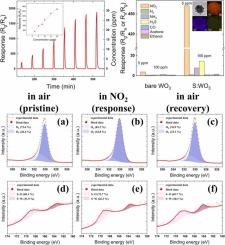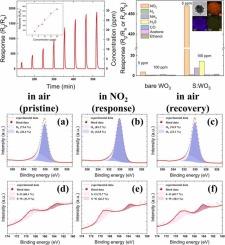非贵金属催化剂包埋WO3微球增强NO2气敏
IF 3.7
1区 化学
Q1 CHEMISTRY, ANALYTICAL
引用次数: 0
摘要
二氧化氮(NO2)是一种严重影响空气污染和人类健康的有毒气体。尽管基于半导体的气体传感器在检测有毒气体方面非常有前途,但它们的性能往往受到低灵敏度和缓慢恢复时间的限制。贵金属催化剂已被广泛用于克服这些限制,通过促进氧从NO2溢出到半导体表面,从而提高传感器的响应。本研究以非贵金属催化剂硫为载体,采用两步水热合成方法在WO3微球上制备了高性能NO2气体传感器。硫的掺入不会改变WO3的结晶度或形貌,但会引入额外的氧空位并促进溢出效应,导致感应响应比裸WO3高100倍以上。在150℃的工作温度下,负载硫的WO3对NO2的响应接近500 ~ 5 ppm,检测限低至50 ppb。该研究提出了一种替代贵金属催化剂的可行方法,并为开发高灵敏度气体传感器提供了一种简单的制造策略。本文章由计算机程序翻译,如有差异,请以英文原文为准。


Non−noble metal catalyst embedded WO3 microspheres for enhancement of NO2 gas sensing
Nitrogen dioxide (NO2) is a toxic gas that critically affects air pollution and human health. Although semiconductor-based gas sensors are highly promising for detecting toxic gases, their performance is often limited by low sensitivity and slow recovery times. Noble metal catalysts have been widely employed to overcome these limitations by promoting oxygen spill-over from NO2 to the semiconductor surface, thereby enhancing sensor response. In this work, we fabricated a high-performance NO2 gas sensor using sulfur, which is non-noble metal catalyst, supported on WO3 microspheres via a two-step hydrothermal synthesis. The incorporation of sulfur did not alter the crystallinity or morphology of the WO3, but it introduced additional oxygen vacancies and facilitated the spill-over effect, resulting in a sensing response more than 100 times higher than that of bare WO3. At an operating temperature of 150°C, the sulfur-loaded WO3 exhibited a response of nearly 500–5 ppm of NO2, with a detection limit as low as 50 ppb. This study suggests a viable approach to replacing noble metal catalysts and presents a simple fabrication strategy for developing highly sensitive gas sensors.
求助全文
通过发布文献求助,成功后即可免费获取论文全文。
去求助
来源期刊

Sensors and Actuators B: Chemical
工程技术-电化学
CiteScore
14.60
自引率
11.90%
发文量
1776
审稿时长
3.2 months
期刊介绍:
Sensors & Actuators, B: Chemical is an international journal focused on the research and development of chemical transducers. It covers chemical sensors and biosensors, chemical actuators, and analytical microsystems. The journal is interdisciplinary, aiming to publish original works showcasing substantial advancements beyond the current state of the art in these fields, with practical applicability to solving meaningful analytical problems. Review articles are accepted by invitation from an Editor of the journal.
 求助内容:
求助内容: 应助结果提醒方式:
应助结果提醒方式:


